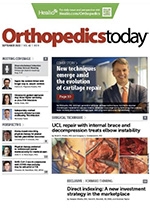Although cartilage repair and restoration still pose clinical challenges in orthopedics, the knowledge of cartilage repair and healing gained in the last decade has resulted in advanced surgical techniques and improved outcomes.
Many cartilage repair technologies available today look similar to those from 10 to 15 years ago, Kai Mithoefer, MD, of the Boston Sports and Shoulder Center and co-director of joint preservation at New England Baptist Hospital, said, noting these technologies have evolved into different techniques that provide better outcomes.
“The individual cartilage repair techniques have advanced to the next-generation technologies by reducing technical shortcoming of earlier generation technologies and with resultant improvement of clinical outcomes,” Mithoefer told Healio/Orthopedics Today.
As one of the most frequently used technologies for cartilage repair, microfracture has shown reasonable midterm to long-term results as long as it has been used for chondral defects with lesions less than 2 cm2 and with healthy surrounding cartilage, Mithoefer said. The quantity and quality of the repair tissue has been a factor in the durability of microfracture, with published literature showing decreased function 2 years after microfracture due to the limited amount and quality of repair tissue fillers, he said.
Improvements in microfracture
Mithoefer said recent discussions about the microfracture technique have focused on the awl or pick used to create small holes in the bone and its effect on the subchondral bone.
“Recent studies have shown that overgrowth of the subchondral bone can occur in up to 63% of the cases and the presence of overgrowth has been associated with an eight-times increased failure rate after microfracture,” Mithoefer said.
These findings have led to the development of new tools, such as nanofracture, which can be gentler on the subchondral bone, he said.
“They do not completely avoid the subchondral changes, but they have been shown in clinical studies to improve outcomes in comparison to the first-generation microfracture,” Mithoefer said.











